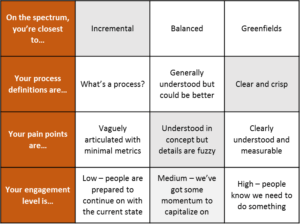Right-Sizing your Current State Assessment
Right-Sizing your Current State Assessment
Clients come to us when they need to redesign their business processes, and one thing is generally true of them all: they believe they need to do an in-depth current state assessment before they put pen to whiteboard to design the future state. They are surprised to learn that not every process project should begin with that sort of activity. If you’re on the process redesign path, use these four questions to right-size your current state assessment to fit the scale of your process redesign effort.
Four Questions to Right-Size your Assessment
1. How much change do you want to reflect in your future state?
NEOS uses three points on a “redesign spectrum” to help clients figure out their appetite for change. Where you fall on the spectrum will help shape the most appropriate current state assessment.
 Incremental change targets tactical improvements to the current state, requiring a detailed understanding of the current state and with little to no emphasis on designing an “ideal” future state. The redesigned processes heavily leverage the current state maps. No significant technology or organizational changes are considered (e.g., job descriptions may be affected but not redesigned). A detailed current state assessment is needed.
Incremental change targets tactical improvements to the current state, requiring a detailed understanding of the current state and with little to no emphasis on designing an “ideal” future state. The redesigned processes heavily leverage the current state maps. No significant technology or organizational changes are considered (e.g., job descriptions may be affected but not redesigned). A detailed current state assessment is needed.
Balanced change emphasizes quick hits and longer-term fixes. Technology and organization changes are considered within the framework of the current state (e.g., no new core admin system but modifications would be possible). A solid current state assessment is needed, but detailed maps and flows may not be.
Greenfield change requires an understanding of the current state, its pain points, and the company’s strategic direction, but an in-depth assessment of current state isn’t necessary. Companies with greenfield appetites are willing to replace existing technology and undertake organizational redesigns to enable the idea future state. A good understanding of pain points is needed, but detailed maps and flows will likely be a waste of time and money.
2. Are your processes well defined from trigger to end-point?
If you were to ask your stakeholders to name your business processes and define them in terms of start, outcome, and major activities, how similar would their lists be? Developing this “inventory” of processes helps scope future state design efforts because you can prioritize processes based on strategic objectives and group processes into future state design sprints. Clients who don’t have a commonly understood process inventory should develop one as part of the current state assessment. In fact, it will be next to impossible to complete any form of a current state assessment without such an inventory.
3. Can you clearly articulate your pain points?
The most important outcome of any current state assessment is a crisp list of what needs to be fixed or addressed in the future state. It’s also critical to understand what’s working well so that you don’t break it in the redesign. The more clearly understood and shared this list is across the stakeholder groups, the less time you need to spend on assessment.
4. Do you need to build engagement within the organization?
Designing a future state is a first step on the path. Implementing the future state is often a bumpy road cluttered with misunderstandings, unrealistic expectations, poor communication, and flat out refusals to accept new ways of doing things. Conducting a current state assessment in the right way is a great way to begin to build engagement and buy-in from key constituencies very early in the change cycle. If you’ve already got a lot of support, spending too much time on current state can frustrate people who are ready to get on with things. Spending too little time, however, may cause people to wonder whether the need to do things differently was validated at all.
Client Case Study
How you answer these four questions will dictate how deep you must dig into your current state before proceeding with future state design. It also indicates the techniques to use in executing the current state assessment. Here is how one of our clients “scored” on these four questions and what we did as a result.

The client determined at the outset that they would not consider wide-scale technological or organizational changes, and they had a good understanding of the definition of the process that needed to be redesigned. They were able to provide a fairly recent process document for the “content creation” process. Various stakeholders understood the process to be more painful than it needed to be, but the exact nature of the pain points was not clear. A few key leaders were in place as sponsors, and because of recent digital content training, the idea of a better, streamlined content creation process was beginning to take hold.
So, how did we customize a current state assessment to this client situation?
- We prepared and distributed an “online interview” to everyone involved with the content creation process. Using SurveyMonkey as our tool, we were able to capture feedback and insights from a wide range of participants.
- We conducted strategy interviews with the two primary sponsors to generate Business-Value statements and target metrics. These served as guiding principles for the process redesign activity.
- We reviewed the documentation the client provided and conducted user observations to vet the current state process. Because of the client’s “incremental” status, if they hadn’t had the process maps, we would have generated them.
- We consolidated pain points from the online interview, strategy interviews, and user observations, and we prioritized them based on the business value statements. These pain points fed into a cross-functional process design session.
- We conducted FutureWeekTM, a cross-functional rapid process design session. For this client, we used the process maps and pain points to lead a 2-day discussion that generated both quick-hits, longer-term fixes, role changes, and policy updates related to a future state process. There were no technology recommendations, but we identified key organizational gaps and recommended immediate hiring of resources to fill those gaps.
Summary
Current state assessment is an important part of any process redesign effort as it generates necessary intelligence to guide future state design. It can get away from you, though, and become a vortex of wasted time, money, and effort if not properly scaled and controlled. Be sure to right-size your current assessment to fit your specific project goals and business objectives.
Carla Gregory, Senior Principal, NEOS LLC
 Carla’s experience combines hands-on insurance industry leadership with professional consulting expertise in the areas of operations effectiveness, business process management, and organization development. Since joining NEOS in 2011, Carla established and currently leads the Business Consulting practice, which provides practical and implementable services to operations leaders facing challenges in designing their future state models. She has spoken at and chaired operational excellence conferences in both insurance and financial services.
Carla’s experience combines hands-on insurance industry leadership with professional consulting expertise in the areas of operations effectiveness, business process management, and organization development. Since joining NEOS in 2011, Carla established and currently leads the Business Consulting practice, which provides practical and implementable services to operations leaders facing challenges in designing their future state models. She has spoken at and chaired operational excellence conferences in both insurance and financial services.
NEOS is a management consulting and technology services firm specializing in financial services, insurance and information media industries. Our employees come from these industries; they understand the problem space allowing them to provide practical solutions that unlock our client’s business value potential.






